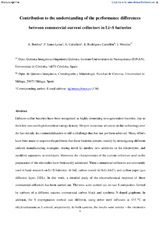Mostrar el registro sencillo del ítem
Contribution to the understanding of the performance differences between commercial current collectors in Li–S batteries
| dc.contributor.author | Benítez de la Torre, A. | |
| dc.contributor.author | Luna-Lama, Fernando | |
| dc.contributor.author | Caballero, Álvaro | |
| dc.contributor.author | Rodríguez-Castellón, Enrique | |
| dc.contributor.author | Morales, Julián | |
| dc.date.accessioned | 2022-03-11T12:14:59Z | |
| dc.date.available | 2022-03-11T12:14:59Z | |
| dc.date.issued | 2021 | |
| dc.identifier.uri | http://hdl.handle.net/10396/22683 | |
| dc.description.abstract | Lithium–sulfur batteries have been recognised as highly promising next-generation batteries, due to their low cost and high theoretical energy density. Despite numerous advances in this technology over the last decade, its commercialisation is still a challenge that has not yet been achieved. Many efforts have been made to improve the problems that these batteries present, mainly by investigating different cathode manufacturing strategies, testing novel Li anodes, new additives in the electrolytes, and modified separators or interlayers. However, the characteristics of the current collectors used in the preparation of the electrodes have been rarely addressed. Three commercial collectors are commonly used in basic research on Li–S batteries: Al foil, carbon coated Al foil (Al-C), and carbon paper (gas diffusion layer, GDL). In this work, a detailed study of the electrochemical response of these commercial collectors has been carried out. The tests were carried out on two S composites formed by carbons of a different natures, commercial carbon black and synthetic N-doped graphene. In addition, the S impregnation method was different, using either melt diffusion at 155 °C or ethylenediamine as S solvent, respectively. In both systems, the results were similar – the electrodes supported on GDL delivered higher specific capacities than those supported on Al and Al-C, with minimal differences between the two. Of the different collector properties examined to explain this behaviour, namely Al corrosion, electrical conductivities, surface-level composition, and surface texture, only the latter had a significant effect in the performance of GDL-based electrodes. SEM images revealed a rough and cracked surface formed by the agglomerated carbon particles that give rise to a complex pore system, predominantly consisting of macropores. All of these features are beneficial for a better anchoring of the active material on the collector surface, in addition to enhancing the wettability of the electrolyte and favouring reaction kinetics. In contrast, the Al-based collector possesses a very smooth and non-porous surface, detrimental to both the active material-substrate interface and the active material impregnation by the electrolyte. | es_ES |
| dc.format.mimetype | application/pdf | es_ES |
| dc.language.iso | eng | es_ES |
| dc.publisher | Elsevier | es_ES |
| dc.rights | https://creativecommons.org/licenses/by-nc-nd/4.0/ | es_ES |
| dc.source | Journal of Energy Chemistry 62, 295-306 (2021) | es_ES |
| dc.subject | Current collector | es_ES |
| dc.subject | Carbon paper | es_ES |
| dc.subject | Aluminum foil | es_ES |
| dc.subject | Lithium–sulfur battery | es_ES |
| dc.title | Contribution to the understanding of the performance differences between commercial current collectors in Li–S batteries | es_ES |
| dc.type | info:eu-repo/semantics/article | es_ES |
| dc.relation.publisherversion | https://doi.org/10.1016/j.jechem.2021.03.014 | es_ES |
| dc.relation.projectID | Gobierno de España. MAT2017-87541-R | es_ES |
| dc.relation.projectID | Junta de Andalucía. FQM-175 | es_ES |
| dc.relation.projectID | Gobierno de España. RTI2018-099668-BC22 | es_ES |
| dc.rights.accessRights | info:eu-repo/semantics/openAccess | es_ES |

